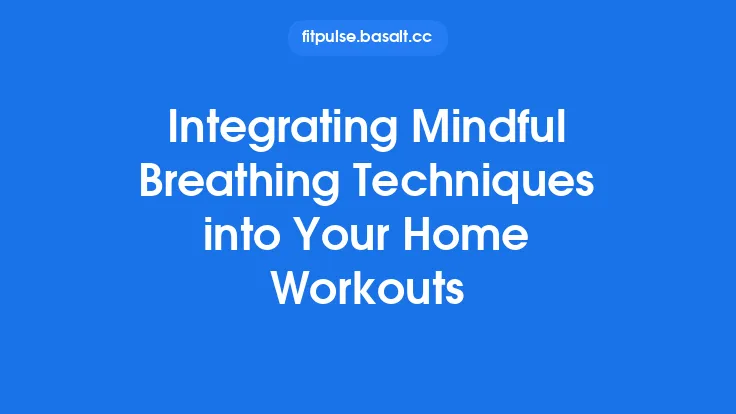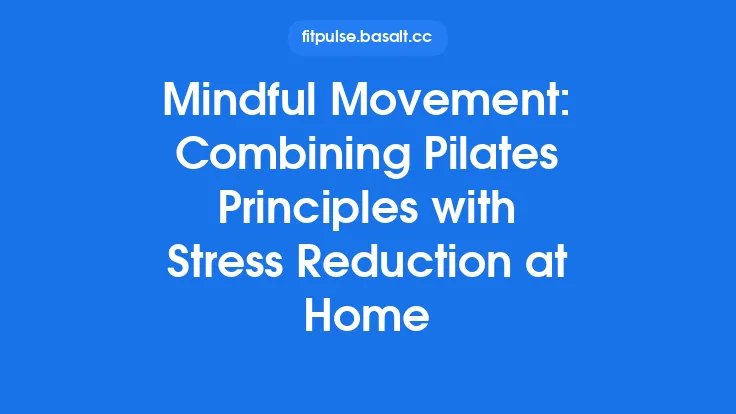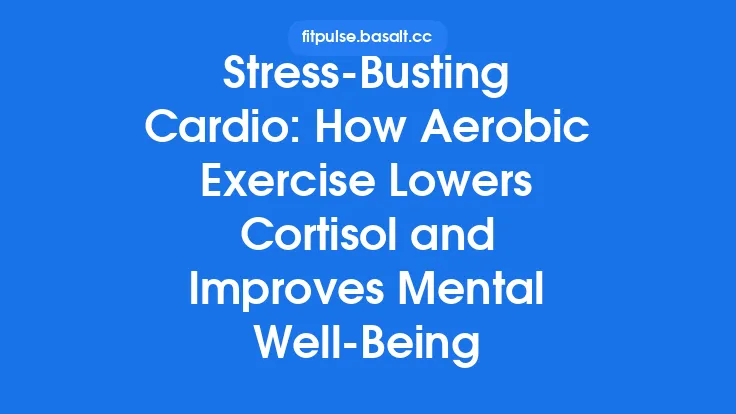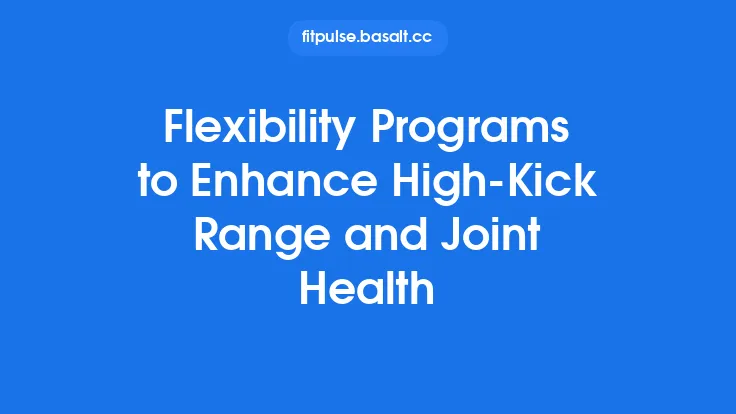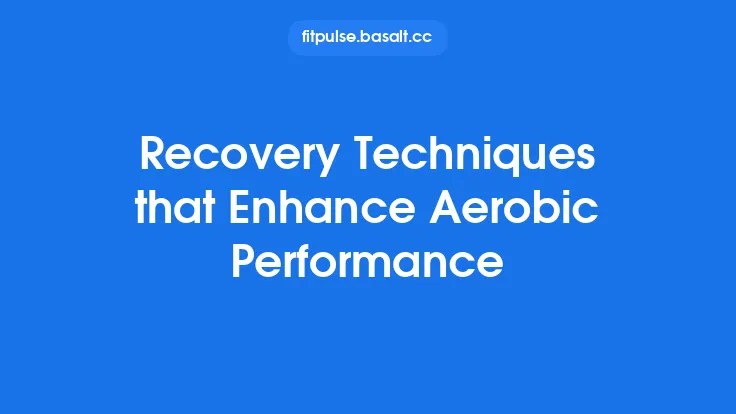When you think of cardio, the image that often comes to mind is a steady rhythm of feet hitting the pavement, a heart rate monitor flashing numbers, and perhaps a playlist that keeps you moving. While those elements are certainly part of an effective aerobic workout, they represent only one side of the equation. The other side—often overlooked but equally powerful—is the way you breathe. By deliberately shaping each inhalation and exhalation, you can transform a routine cardio session into a practice that not only elevates your fitness but also serves as a potent tool for stress reduction. This approach, sometimes called “mindful cardio,” blends the physiological benefits of aerobic exercise with the calming influence of breathwork, creating a synergistic effect that helps the nervous system shift from a state of fight‑or‑flight to one of rest‑and‑digest. In the sections that follow, we will explore the science behind this integration, outline practical techniques for a variety of cardio modalities, and provide a step‑by‑step framework for building a sustainable, stress‑relieving cardio practice that you can adapt to any fitness level.
Understanding the Mind‑Body Connection in Cardio
Cardiovascular exercise is fundamentally a stressor: it raises heart rate, increases oxygen demand, and activates the sympathetic branch of the autonomic nervous system (ANS). This activation is essential for improving aerobic capacity, but it also triggers the release of catecholamines (epinephrine and norepinephrine) that prepare the body for action. When the workout ends, the parasympathetic branch of the ANS should take over, slowing the heart rate, lowering blood pressure, and promoting recovery. The speed and completeness of this transition are key determinants of how “stressed” you feel after a session.
Breathing sits at the crossroads of these two branches. The act of inhalation is naturally linked to sympathetic activation, while exhalation is associated with parasympathetic dominance. By consciously extending the exhalation phase, you can accelerate the shift toward parasympathetic tone, thereby reducing the lingering sense of tension that sometimes follows a vigorous cardio bout. This is not merely a mental trick; it is a physiological lever that can be measured through heart‑rate variability (HRV), respiratory sinus arrhythmia (RSA), and even hormonal markers of stress.
Fundamentals of Breath Control
Before integrating breathwork into cardio, it is useful to master a few foundational patterns:
| Breath Pattern | Inhale : Exhale Ratio | Typical Use | Key Benefits |
|---|---|---|---|
| Box Breathing | 4 : 4 : 4 : 4 (inhale‑hold‑exhale‑hold) | Warm‑up, cool‑down | Balances sympathetic and parasympathetic activity, improves focus |
| 4‑7‑8 Breathing | 4 : 7 : 8 (inhale‑hold‑exhale) | Post‑cardio relaxation | Enhances vagal tone, promotes rapid HRV recovery |
| Diaphragmatic (Belly) Breathing | Variable, but exhale longer than inhale | Throughout cardio | Increases lung efficiency, reduces perceived exertion |
| Pursed‑Lips Breathing | Inhale through nose, exhale through pursed lips (2:4 ratio) | High‑intensity intervals | Improves CO₂ clearance, stabilizes heart rate |
The most universally applicable pattern for cardio is diaphragmatic breathing with an extended exhalation (often a 1:2 or 1:3 inhale‑to‑exhale ratio). This technique encourages full lung expansion, maximizes oxygen uptake, and leverages the natural parasympathetic boost that occurs during exhalation.
Physiological Mechanisms Linking Breathing and Stress
- Respiratory Sinus Arrhythmia (RSA)
RSA describes the natural fluctuation of heart rate that occurs with the breathing cycle: the heart rate accelerates during inhalation and decelerates during exhalation. A pronounced RSA is a marker of high vagal (parasympathetic) activity and is associated with better emotional regulation. By lengthening the exhalation, you amplify the deceleration phase, thereby increasing RSA amplitude and fostering a calmer physiological state.
- Baroreceptor Reflex Modulation
Baroreceptors—pressure sensors located in the carotid sinus and aortic arch—communicate with the brainstem to regulate blood pressure. Slow, deep exhalations increase intrathoracic pressure, which transiently raises baroreceptor firing and triggers a reflexive reduction in sympathetic outflow. This contributes to a drop in heart rate and blood pressure post‑exercise, smoothing the transition to recovery.
- Chemoreceptor Sensitivity
The body’s chemoreceptors monitor blood CO₂ levels. Controlled breathing that maintains a slightly higher CO₂ concentration (by avoiding hyperventilation) can reduce the sensation of breathlessness and the associated anxiety that sometimes accompanies high‑intensity cardio. Techniques like pursed‑lips breathing help retain CO₂, stabilizing the respiratory drive.
- Neurotransmitter Balance
Slow breathing has been shown to increase gamma‑aminobutyric acid (GABA) activity in the brain, an inhibitory neurotransmitter that dampens neuronal excitability. Elevated GABA levels correlate with reduced anxiety and improved mood, providing a neurochemical pathway through which mindful breathing can mitigate stress.
Integrating Breathwork into Common Cardio Modalities
1. Walking and Light Jogging
- Baseline Rhythm: Aim for a cadence of 150–170 steps per minute (spm).
- Breath Pattern: Inhale for 2 steps, exhale for 4 steps (2:4 ratio).
- Implementation: Begin with a 5‑minute warm‑up at a comfortable pace, focusing on diaphragmatic expansion. As you settle into the rhythm, consciously lengthen the exhalation by counting silently or using a metronome app set to the step cadence.
2. Cycling (Stationary or Road)
- Baseline Rhythm: Align breathing with pedal strokes; a common pattern is 1:2 (one full pedal revolution for inhale, two for exhale).
- Breath Pattern: Inhale through the nose, exhale through the mouth with pursed lips.
- Implementation: During steady‑state rides (zone 2 intensity), maintain a smooth, continuous exhalation that coincides with the downstroke of the pedal. For interval work, use a “recovery breath” (4‑7‑8) during low‑intensity phases to reset the ANS before the next high‑intensity burst.
3. Rowing
- Baseline Rhythm: The rowing stroke naturally divides into a drive (pull) and recovery (return).
- Breath Pattern: Inhale during the recovery (arms extending, body sliding forward), exhale during the drive (legs extending, arms pulling).
- Implementation: Emphasize a slow, controlled exhalation that lasts the entire drive phase (approximately 2–3 seconds). This aligns the powerful muscular contraction with parasympathetic activation, reducing the perceived effort.
4. High‑Intensity Interval Training (HIIT)
- Baseline Rhythm: Intervals typically last 20–60 seconds of work followed by 30–90 seconds of rest.
- Breath Pattern: During work phases, maintain a natural but not forced breathing cadence (e.g., 1:1). During rest, switch to a 4‑7‑8 pattern to accelerate parasympathetic rebound.
- Implementation: Use a timer that cues the transition not only for the interval but also for the breath cue (“inhale‑hold‑exhale”). This trains the body to quickly toggle between sympathetic and parasympathetic states, enhancing stress resilience.
5. Swimming
- Baseline Rhythm: Each stroke cycle (e.g., freestyle) offers a natural breathing window.
- Breath Pattern: Inhale quickly during the head turn, then exhale steadily underwater for the duration of the stroke.
- Implementation: Practice “long exhalation” drills where you count to three or four while exhaling underwater, ensuring the exhalation outlasts the inhalation. This also improves buoyancy control and reduces the urge to gasp for air.
Designing a Mindful Cardio Session
| Phase | Duration | Focus | Breath Cue |
|---|---|---|---|
| Warm‑up | 5–10 min | Light movement, body awareness | Diaphragmatic breathing, 2:4 step‑to‑breath ratio |
| Core Cardio | 20–30 min (steady‑state) or 10–15 min (intervals) | Aerobic stimulus | Extended exhalation (1:2 or 1:3), maintain rhythm |
| Skill/Technique Block | 5–10 min | Specific breath‑movement integration (e.g., rowing drive) | Match exhale to power phase |
| Cool‑down | 5–10 min | Gradual return to baseline, stress release | 4‑7‑8 breathing, box breathing for final 2 min |
| Reflection | 2–3 min | Mental check‑in, note stress levels | Slow, natural breathing, body scan |
Key Principles
- Consistency Over Intensity – The stress‑reduction benefits of mindful breathing accrue most reliably when practiced regularly, even at moderate cardio intensities.
- Synchrony – Align the breath with the mechanical rhythm of the activity; this reduces cognitive load and allows the breath to become an automatic regulator.
- Progressive Overload of Mindfulness – Start with simple 2:4 ratios, then gradually increase exhalation length or add a brief hold after inhalation to deepen parasympathetic activation.
- Environment – Choose a setting with minimal auditory distractions for the first few weeks; this helps you tune into the subtle sensations of breath and heartbeat.
Progression and Adaptation
| Stage | Cardio Intensity | Breath Complexity | Goal |
|---|---|---|---|
| Novice | Zone 1–2 (50‑65 % VO₂max) | Simple diaphragmatic breathing, 2:4 ratio | Establish baseline RSA, reduce immediate post‑exercise tension |
| Intermediate | Zone 2–3 (65‑75 % VO₂max) | Introduce brief inhalation holds (1‑2 sec) or box breathing during warm‑up/cool‑down | Strengthen baroreceptor reflex, improve HRV recovery |
| Advanced | Zone 3–4 (75‑85 % VO₂max) or HIIT | Combine multiple patterns (e.g., 4‑7‑8 during rest intervals, pursed‑lips during high‑intensity bursts) | Optimize autonomic flexibility, enhance stress resilience under high load |
Progression should be guided by subjective stress scores (e.g., a 0‑10 “stress after workout” rating) and objective metrics such as HRV measured first thing in the morning. If HRV trends downward for three consecutive days, consider reducing exhalation length or adding an extra cool‑down breathing block.
Tools for Monitoring Stress Response
- Heart‑Rate Variability (HRV) Apps – Devices like WHOOP, Oura Ring, or Polar H10 provide nightly HRV scores that reflect parasympathetic tone. A rising trend indicates successful stress mitigation.
- Respiratory Rate Sensors – Some smartwatches (e.g., Apple Watch) can track breaths per minute; a lower resting respiratory rate often correlates with improved stress handling.
- Subjective Stress Journals – Record perceived stress before and after each session, noting any external factors (workload, sleep) that may influence the reading.
- Biofeedback Devices – Handheld HRV biofeedback tools (e.g., Inner Balance) allow you to see real‑time changes in heart‑rate patterns as you adjust your breathing, reinforcing the mind‑body link.
Practical Tips for Everyday Integration
- Anchor Breath to a Cue – Use a metronome, music beat, or footfall as a reminder to exhale fully.
- Micro‑Sessions – Even a 5‑minute mindful walk during a lunch break can reset the ANS, making longer cardio sessions feel less taxing.
- Pair with Mindful Moments – After a cardio session, spend a minute focusing on the sensations in your chest and abdomen; this consolidates the parasympathetic shift.
- Use Visual Aids – Imagine the breath as a wave: inhale as the wave rises, exhale as it recedes, pulling tension away.
- Educate Your Body – Start each new cardio modality with a “breath rehearsal” (e.g., 30 seconds of diaphragmatic breathing) before adding movement.
Common Pitfalls and How to Avoid Them
| Pitfall | Why It Happens | Solution |
|---|---|---|
| Hyperventilation during high intensity | Over‑reliance on mouth breathing, trying to “catch up” with oxygen demand. | Practice pursed‑lips exhalation, keep inhalations short and through the nose. |
| Forgetting the breath during distraction | Cognitive load from scenery, conversation, or music. | Use a simple mantra (“inhale… exhale…”) or a subtle wrist tap to remind yourself. |
| Over‑complicating patterns early on | Trying to master box breathing while sprinting. | Keep the first few weeks to a single 2:4 ratio; add complexity only after the pattern feels automatic. |
| Neglecting the cool‑down | Rushing off the treadmill to answer a call. | Schedule a 2‑minute buffer in your calendar; treat the cool‑down as part of the workout. |
| Relying solely on HRV without context | HRV can dip due to illness, alcohol, or poor sleep, not just cardio stress. | Pair HRV data with subjective stress scores and lifestyle factors. |
Sustainable Stress Resilience Through Mindful Cardio
Integrating purposeful breathing into aerobic exercise is more than a performance tweak; it is a lifestyle strategy that equips the nervous system with a built‑in “reset button.” By consistently extending exhalations, aligning breath with movement, and using simple, repeatable patterns, you can:
- Accelerate autonomic recovery – Faster return to parasympathetic dominance after each session.
- Enhance perceived effort – Lower rating of perceived exertion (RPE) at the same workload, making workouts feel easier.
- Build mental flexibility – The practice of returning attention to breath during physical strain trains the brain to disengage from stressors more readily.
- Create a portable stress‑relief tool – Once mastered, the breath patterns can be applied in non‑exercise contexts (e.g., before a meeting, during a commute).
The beauty of mindful cardio lies in its adaptability. Whether you prefer a brisk walk in the park, a spin class, a rowing session on the lake, or a high‑intensity circuit, the same breathing principles can be woven into the fabric of the activity. Over time, the habit of pairing breath with motion becomes second nature, allowing you to reap the dual benefits of cardiovascular fitness and a calmer, more resilient mind—without the need for additional equipment, lengthy meditation sessions, or complex protocols.
By committing to this integrated approach, you turn every cardio workout into a dual‑purpose practice: one that strengthens the heart and lungs while simultaneously training the nervous system to handle stress with greater ease. The result is a sustainable, evergreen habit that supports not only physical health but also the mental clarity and emotional balance essential for thriving in today’s fast‑paced world.
